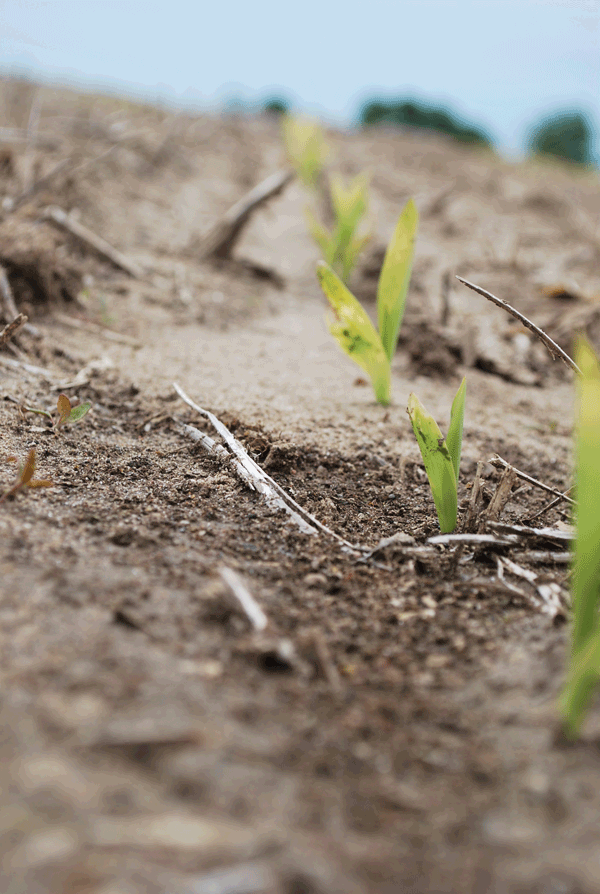The quest for nitrogen fixing corn
RESEARCHERS TESTING POTENTIALLY CRITICAL ELEMENT
a bacterium that may be capable of actively fixing nitrogen in corn has been studied and tested in Ontario. Although research is still very preliminary, the study may provide an important clue in the search for a nitrogen-fixing cereal crop inoculant or biofertilizer.
For years scientists have been working hard to discover the key to nitrogen fixation in corn, but recent work by a research team at Agriculture and Agri-Food Canada (AAFC) has shown a nitrogen fixing bacterium that may unlock the mystery. The bacterium is called Gluconacetobacter diazotrophicus and was originally discovered in sugarcane during the late 1980s. A team led by Dr. Lining Tian, a research scientist with the AAFC Southern Crop Protection and Food Research Centre in London, was able to successfully introduce G. diazotrophicus into a number of corn varieties. Tian says that their next step with the project is to test that the results achieved under laboratory conditions also apply in a cropping environment.
“We know that the bacterium can be introduced into some corn plants grown in a greenhouse,” says Tian. “We don’t know if the bacterium will be stable in a field setting.”

Tian says a limited field trial will begin this year in a few selected locations. The research team will be closely studying the behaviour of the bacterium to determine if they continue to successfully coexist within corn plants for the duration of the growing season. Researchers hypothesize that successful colonization may be related to sugar concentrations in plants and are curious to discover if this is related to nitrogen fixation. Tian says there are still many important factors they hope to understand.
“At this point, we don’t know if this bacterium can be transferred to successive plant generations,” says Tian.
the g. diazotrphicus advantage
G. diazotrophicus can grow in a wide range of conditions, such as low pH, high sucrose concentrations and high salt conditions. The bacterium is unique because it allows nitrogen fixation to remain active in nitrogen-fertilized fields, unlike soybean innoculating Rhizobium bacteria which shut down when the soil is high in nitrogen. Compared to Rhizobium bacteria, Tian says G. diazotrophicus could probably be more aggressive as well. He says their observations show G. diazotrophicus can enter a corn plant at multiple sites, such as stems and leaves, whereas the bacteria that colonize legumes are limited to root nodules alone.
“Colonization of the plant by G. diazotrophicus is different from Rhizobia because there are no nodule structures formed,” says Tian. “This bacterium is found in intercellular spaces of different parts of the plant.”
In addition to their ability to actively fix atmospheric nitrogen in intercellular space, G. diazotrophicus appears to be less plant species specific. The bacterium may be introduced into different plant species and potentially, different cereal crops could have been selected for testing in Ontario. But, Tian says that corn’s biological heritage, and the potential to greatly benefit the agricultural industry, were the major factors that made his decision to select corn for this project.
“First, sugarcane and corn are monocot plants and are closely related taxonomically,” says Tian. “Another reason is, corn is a major cereal crop and especially needs a lot of nitrogen fertilizer to attain a high yield.”
future potential
With so much more research still required to establish the true potential of G. diazotrophicus in helping to achieve nitrogen fixation in corn, Dr. Tian says the full impact of this current research is yet to be determined. Still, he knows that the work being done by his team today is important ground work in the scientific community. Improving scientific knowledge has always been the basis for developing beneficial technologies he says.
“If we understand more about this bacterium, we will have a better potential to use this bacterium in corn plants for nitrogen fixation,” says. Tian. “Nitrogen fixation in corn is an interesting as well as a challenging study.” •







